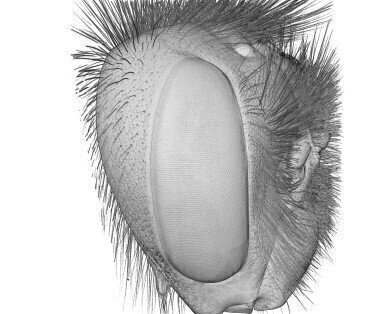-
 3D image of the head of a bumblebee (Credit: Pierre Tichit)
3D image of the head of a bumblebee (Credit: Pierre Tichit)
News & Views
Images Explore the Effects of Eyesize on Vision of Bees
Oct 11 2019
As important pollinators, particularly in northern Europe, bees have to visually navigate complex environments in search of nectar; while extensive research on honeybees has revealed how they process and learn the visual information necessary for this, we know much less about bumblebee eyesight.
Researchers at Stockholm University and Lund University in Sweden, working with colleagues from Germany and Diamond Light Source, the UK’s national synchrotron, have developed a new technique combining computer-assisted tomography and very high-resolution imaging to generate images of the compound eyes of buff-tailed bumblebee to determine what they see in various parts of their field of view.
Associate Professor Emily Baird from Stockholm University explains “By giving us a deeper understanding of how bumblebees perceive the world, this research can help us to better understand the pollination behaviour of bees in general and may aid in the development of more efficient strategies for conserving threatened species. For example, this could help researchers to determine which flowers different bees see easily, and which ones they find it harder to distinguish. The tomography beamline I13-2 at Diamond helped us to develop and refine our methodology and has been fundamental in making this work possible.”
Senior Support Scientist Dr Andrew Bodey adds “The high-throughput, high-contrast, high-resolution 3D imaging at I13-2 enabled high-quality data to be generated for a large number of samples in just a few days.”
In this study* they explored the effect of size on the visual capacity of buff-tailed bumblebees, (Bombus terrestris) by comparing the eye structures of individuals of different sizes. They used X-ray microtomography performed at beamline I13-2 to measure the 3D structure of the compound eyes and then used those measurements to build 3D models of the eyes. By using computational geometry, they were able to calculate the sensitivity, acuity and viewing direction across the surface of each model eye. The novel technique they developed allowed the researchers to map eye properties and visual capabilities onto common, world-referenced coordinates.
Although bumblebee eyes have not been well researched, extensive behavioural, anatomical and physiological studies have been carried out on honeybee eyes and so the team also used their technique to examine the eyes of European honeybees (Apis mellifera) to validate their new methodology and for comparison against their bumblebee data.
*Published in eLife
Digital Edition
Lab Asia 31.2 April 2024
April 2024
In This Edition Chromatography Articles - Approaches to troubleshooting an SPE method for the analysis of oligonucleotides (pt i) - High-precision liquid flow processes demand full fluidic c...
View all digital editions
Events
Apr 22 2024 Marrakech, Morroco
Making Pharmaceuticals Exhibition & Conference
Apr 23 2024 Coventry, UK
Apr 23 2024 Kintex, South Korea
Apr 23 2024 Seoul, South Korea
Apr 24 2024 Jakarta, Indonesia







.jpg)









